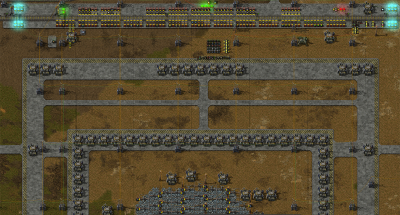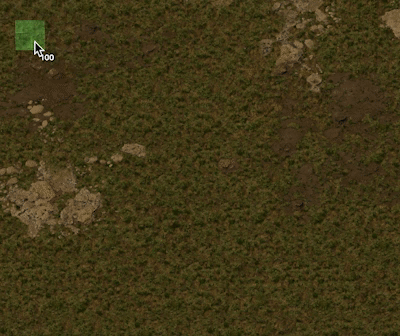Tile: Difference between revisions
No edit summary |
m (direct link) |
||
| (5 intermediate revisions by 2 users not shown) | |||
| Line 1: | Line 1: | ||
{{Languages}} | {{Languages}}{{About|placeable tiles|the area and distance unit|map structure#Tile|caption1=map structure}} | ||
[[File:Tiles-ExamplePaths.png|thumb|right|400px|An example of using [[refined concrete]] and [[refined hazard concrete]] for aesthetic design and to improve walking speed around a [[mining]] outpost.]] | |||
A '''tile''' is an item that can be placed by the player to modify the 'floor' of the game world. [[Landfill]] places a ground tile that converts [[water]] to buildable ground. The other tiles place paths which improve walking and driving speeds and can be used for decorative purposes, at the cost of significantly reducing the absorption of [[pollution]]. | |||
== List of tiles == | |||
== | {| class="wikitable" | ||
!style="width: 170px;" |Name | |||
!Type | |||
|Walking speed modifier | |||
|- | |||
| [[Stone brick]] || Path || +30% | |||
|- | |||
| [[Concrete]] || Path || +40% | |||
|- | |||
| [[Hazard concrete]] || Path || +40% | |||
|- | |||
| [[Refined concrete]] || Path || +50% | |||
|- | |||
| [[Refined hazard concrete]] || Path || +50% | |||
|- | |||
| [[Landfill]] || Ground || N/A | |||
|} | |||
== Paths == | |||
Path tiles apply bonuses to the walking speed of the player and reduce rolling resistances for [[car]]s and [[tank]]s, improving their acceleration and top speed. They do not increase the speed of [[enemies]]. | |||
Paths effectively prevent the absorption of pollution by the underlying terrain, which can lead to an increased number of attacks from enemies. | |||
In addition to the practical benefits to walking and driving speed, paths are often used for decorative purposes and to visually highlight important areas of the base. | |||
== Usage == | |||
[[File:Tiles-DemoPlaceRemove.gif|thumb|right|400x336px|A demonstration of first placing then removing refined concrete. The building area is adjusted several times.]] | |||
=== Placing === | |||
Tiles are placed by holding them in the hand and clicking {{Keybinding|lmb}}. The mouse can be dragged while the button is held to 'paint' tiles over a wide area. | |||
The building area for tiles can be increased by pressing {{Keybinding|PAD +}} and reduced again by pressing {{Keybinding|PAD -}}. This allows the player to place a much larger number of tiles at one time, effectively having a larger 'brush' with which to apply tiles to the map. | |||
Path tiles can be placed where entities already exist and will appear underneath them. Likewise entities can later be placed on top of constructed tiles, including paths being placed on top of landfill. Landfill can only be placed on water. | |||
=== Removing paths === | |||
Path tiles can be removed (mined) by holding {{Keybinding|rmb}} while holding any type of tile in the hand. As with placing tiles, the mouse can be dragged over an area and the size of the building area can be increased or decreased to control how many tiles will be removed at a time. Mined path tiles will be placed back in the player's inventory. | |||
Landfill cannot be removed once placed. | |||
=== Swapping paths === | |||
Any path tile can be placed over any other path tile to replace it. The original tiles will be placed back into the player's inventory. | |||
=== Blueprints, deconstruction planners and construction robots === | |||
Tiles are not included in a [[blueprint]] unless they are the only eligible object in the selected area, or when the '''Tiles''' tick-box is ticked. Within a blueprint it is not currently possible for one tile to exist on top of another; in practice this means that a path tile such as [[stone brick]] or [[concrete]] cannot exist on top of landfill in a blueprint. If a blueprint is taken of a path tile on top of landfill, only the path tile will be stored in the blueprint. | |||
When a filtered [[deconstruction planner]] is used tiles are configured separately from entities, appearing under the '''Tiles''' tab. | |||
Tile [[ghost]]s will be constructed by [[construction robot]]s. As construction robots are limited in the number of objects they can hold at once, and given that paths often involve hundreds or thousands of tiles, placing a large area of path or landfill with bots may take a long time and draw a significant amount of [[electric system|electricity]] for bot recharging. | |||
== History == | |||
{{History|0.17.10| | |||
* Landfill is now a separate tile, differentiated from grass-1.}} | |||
{{History|0.17.0| | |||
* Landfill can now be included in blueprints and placed by construction robots. | |||
* Tile construction jobs are now handled separately by construction robots, to prevent entity ghosts not being built due to large number of tile ghosts.}} | |||
{{History|0.16.27| | |||
* Refined concrete and refined hazard concrete introduced.}} | |||
{{History|0.13.0| | |||
* Landfill introduced. | |||
* Hazard concrete introduced.}} | |||
{{History|0.12.0| | |||
* Concrete introduced.}} | |||
{{History|0.3.0| | |||
* Stone brick introduced.}} | |||
== See also == | |||
* [[Blueprint]] | |||
* [[Deconstruction planner]] | |||
* [[Construction robot]] | |||
Latest revision as of 15:41, 28 March 2019
This article is about placeable tiles. For the area and distance unit, see map structure.

A tile is an item that can be placed by the player to modify the 'floor' of the game world. Landfill places a ground tile that converts water to buildable ground. The other tiles place paths which improve walking and driving speeds and can be used for decorative purposes, at the cost of significantly reducing the absorption of pollution.
List of tiles
| Name | Type | Walking speed modifier |
|---|---|---|
| Stone brick | Path | +30% |
| Concrete | Path | +40% |
| Hazard concrete | Path | +40% |
| Refined concrete | Path | +50% |
| Refined hazard concrete | Path | +50% |
| Landfill | Ground | N/A |
Paths
Path tiles apply bonuses to the walking speed of the player and reduce rolling resistances for cars and tanks, improving their acceleration and top speed. They do not increase the speed of enemies.
Paths effectively prevent the absorption of pollution by the underlying terrain, which can lead to an increased number of attacks from enemies.
In addition to the practical benefits to walking and driving speed, paths are often used for decorative purposes and to visually highlight important areas of the base.
Usage
Placing
Tiles are placed by holding them in the hand and clicking Left mouse button. The mouse can be dragged while the button is held to 'paint' tiles over a wide area.
The building area for tiles can be increased by pressing PAD + and reduced again by pressing PAD -. This allows the player to place a much larger number of tiles at one time, effectively having a larger 'brush' with which to apply tiles to the map.
Path tiles can be placed where entities already exist and will appear underneath them. Likewise entities can later be placed on top of constructed tiles, including paths being placed on top of landfill. Landfill can only be placed on water.
Removing paths
Path tiles can be removed (mined) by holding Right mouse button while holding any type of tile in the hand. As with placing tiles, the mouse can be dragged over an area and the size of the building area can be increased or decreased to control how many tiles will be removed at a time. Mined path tiles will be placed back in the player's inventory.
Landfill cannot be removed once placed.
Swapping paths
Any path tile can be placed over any other path tile to replace it. The original tiles will be placed back into the player's inventory.
Blueprints, deconstruction planners and construction robots
Tiles are not included in a blueprint unless they are the only eligible object in the selected area, or when the Tiles tick-box is ticked. Within a blueprint it is not currently possible for one tile to exist on top of another; in practice this means that a path tile such as stone brick or concrete cannot exist on top of landfill in a blueprint. If a blueprint is taken of a path tile on top of landfill, only the path tile will be stored in the blueprint.
When a filtered deconstruction planner is used tiles are configured separately from entities, appearing under the Tiles tab.
Tile ghosts will be constructed by construction robots. As construction robots are limited in the number of objects they can hold at once, and given that paths often involve hundreds or thousands of tiles, placing a large area of path or landfill with bots may take a long time and draw a significant amount of electricity for bot recharging.
History
- 0.17.10:
- Landfill is now a separate tile, differentiated from grass-1.
- 0.17.0:
- Landfill can now be included in blueprints and placed by construction robots.
- Tile construction jobs are now handled separately by construction robots, to prevent entity ghosts not being built due to large number of tile ghosts.
- 0.16.27:
- Refined concrete and refined hazard concrete introduced.
- 0.13.0:
- Landfill introduced.
- Hazard concrete introduced.
- 0.12.0:
- Concrete introduced.
- 0.3.0:
- Stone brick introduced.
